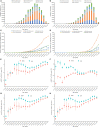The temporal trend of disease burden attributable to metabolic risk factors in China, 1990-2019: An analysis of the Global Burden of Disease study
- PMID: 36687675
- PMCID: PMC9846330
- DOI: 10.3389/fnut.2022.1035439
The temporal trend of disease burden attributable to metabolic risk factors in China, 1990-2019: An analysis of the Global Burden of Disease study
Abstract
Background and aims: The disease burden attributable to metabolic risk factors is rapidly increasing in China, especially in older people. The objective of this study was to (i) estimate the pattern and trend of six metabolic risk factors and attributable causes in China from 1990 to 2019, (ii) ascertain its association with societal development, and (iii) compare the disease burden among the Group of 20 (G20) countries.
Methods: The main outcome measures were disability-adjusted life-years (DALYs) and mortality (deaths) attributable to high fasting plasma glucose (HFPG), high systolic blood pressure (HSBP), high low-density lipoprotein (HLDL) cholesterol, high body-mass index (HBMI), kidney dysfunction (KDF), and low bone mineral density (LBMD). The average annual percent change (AAPC) between 1990 and 2019 was analyzed using Joinpoint regression.
Results: For all six metabolic risk factors, the rate of DALYs and death increased with age, accelerating for individuals older than 60 and 70 for DALYs and death, respectively. The AAPC value in rate of DALYs and death were higher in male patients than in female patients across 20 age groups. A double-peak pattern was observed for AAPC in the rate of DALYs and death, peaking at age 20-49 and at age 70-95 plus. The age-standardized rate of DALYs increased for HBMI and LBMD, decreased for HFPG, HSBP, KDF, and remained stable for HLDL from 1990 to 2019. In terms of age-standardized rate of DALYs, there was an increasing trend of neoplasms and neurological disorders attributable to HFPG; diabetes and kidney diseases, neurological disorders, sense organ diseases, musculoskeletal disorders, neoplasms, cardiovascular diseases, digestive diseases to HBMI; unintentional injuries to LBMD; and musculoskeletal disorders to KDF. Among 19 countries of Group 20, in 2019, the age-standardized rate of DALYs and death were ranked fourth to sixth for HFPG, HSBP, and HLDL, but ranked 10th to 15th for LBMD, KDF, and HBMI, despite the number of DALYs and death ranked first to second for six metabolic risk factors.
Conclusions: Population aging continuously accelerates the metabolic risk factor driven disease burden in China. Comprehensive and tight control of metabolic risk factors before 20 and 70 may help to mitigate the increasing disease burden and achieve healthy aging, respectively.
Keywords: China; aging; disease burden; metabolic risk factors; temporal trend.
Copyright © 2023 Jin, So, Cerin, Barnett, Mubarik, Hezam, Feng, Wang, Huang, Zhong, Hayat, Wang, Wu, Xu, Zou, Lim, Cai, Song, Tam and Wu.
Conflict of interest statement
The authors declare that the research was conducted in the absence of any commercial or financial relationships that could be construed as a potential conflict of interest.
Figures


Similar articles
-
Global burden, trends and inequalities for ischaemic heart disease attributable to high fasting plasma glucose, high low-density lipoprotein cholesterol and high systolic blood pressure, 1990-2021: An analysis of the Global Burden of Disease Study 2021.Diabetes Obes Metab. 2025 Apr;27(4):2070-2085. doi: 10.1111/dom.16199. Epub 2025 Feb 17. Diabetes Obes Metab. 2025. PMID: 39962724
-
Pattern and trend of five major musculoskeletal disorders in China from 1990 to 2017: findings from the Global Burden of Disease Study 2017.BMC Med. 2021 Feb 4;19(1):34. doi: 10.1186/s12916-021-01905-w. BMC Med. 2021. PMID: 33536019 Free PMC article.
-
Disease burden of cancers attributable to high fasting plasma glucose from 1990 to 2021 and projections until 2031 in China.Cancer Epidemiol. 2025 Feb;94:102725. doi: 10.1016/j.canep.2024.102725. Epub 2024 Dec 20. Cancer Epidemiol. 2025. PMID: 39708577
-
Burden of ischemic stroke attributable to high low-density lipoprotein cholesterol in China from the global burden of disease study 2021.Sci Rep. 2025 Jun 6;15(1):20037. doi: 10.1038/s41598-025-04677-y. Sci Rep. 2025. PMID: 40481123 Free PMC article.
-
Global, regional, and national burden of 12 mental disorders in 204 countries and territories, 1990-2019: a systematic analysis for the Global Burden of Disease Study 2019.Lancet Psychiatry. 2022 Feb;9(2):137-150. doi: 10.1016/S2215-0366(21)00395-3. Epub 2022 Jan 10. Lancet Psychiatry. 2022. PMID: 35026139 Free PMC article.
Cited by
-
Temporal trends in mortality of tuberculosis attributable to high fasting plasma glucose in China from 1990 to 2019: a joinpoint regression and age-period-cohort analysis.Front Public Health. 2023 Jul 27;11:1225931. doi: 10.3389/fpubh.2023.1225931. eCollection 2023. Front Public Health. 2023. PMID: 37575123 Free PMC article.
-
Trends in breast cancer mortality attributable to metabolic risks in Chinese women from 1990 to 2019: an age-period-cohort analysis.Front Oncol. 2024 Apr 16;14:1369027. doi: 10.3389/fonc.2024.1369027. eCollection 2024. Front Oncol. 2024. PMID: 38690163 Free PMC article.
-
Comparative analysis of metabolic risks and related non-communicable disease burden across sociodemographic index regions from 1990 to 2021.BMJ Open. 2025 Aug 10;15(8):e097748. doi: 10.1136/bmjopen-2024-097748. BMJ Open. 2025. PMID: 40789588 Free PMC article.
-
Global, regional, and national burden of cardiovascular disease attributable to high body mass index from 1990 to 2021 and projection to 2045.Front Endocrinol (Lausanne). 2025 Apr 28;16:1546176. doi: 10.3389/fendo.2025.1546176. eCollection 2025. Front Endocrinol (Lausanne). 2025. PMID: 40357206 Free PMC article.
References
-
- Collaborators GBDD. Global age-sex-specific fertility, mortality, healthy life expectancy (HALE), and population estimates in 204 countries and territories, 1950-2019: a comprehensive demographic analysis for the Global Burden of Disease Study 2019. Lancet. (2020) 396:1160–203. 10.1016/S0140-6736(20)30977-6 - DOI - PMC - PubMed
LinkOut - more resources
Full Text Sources

